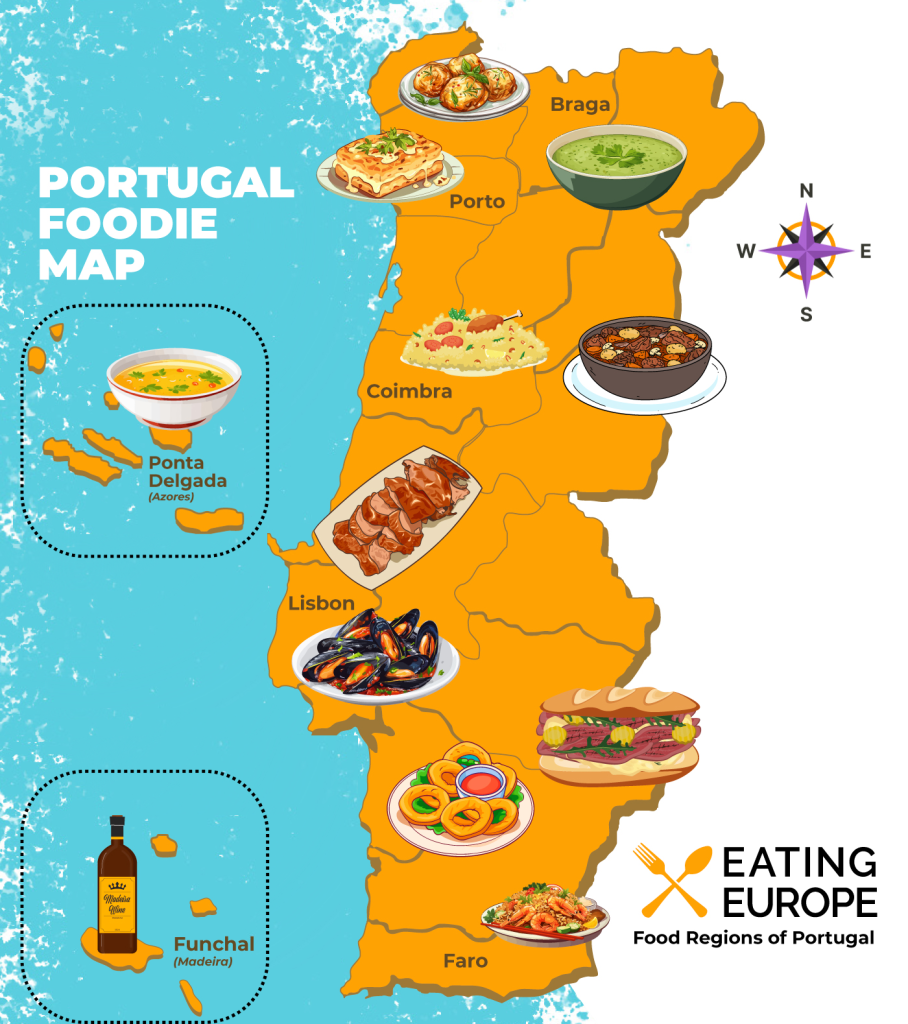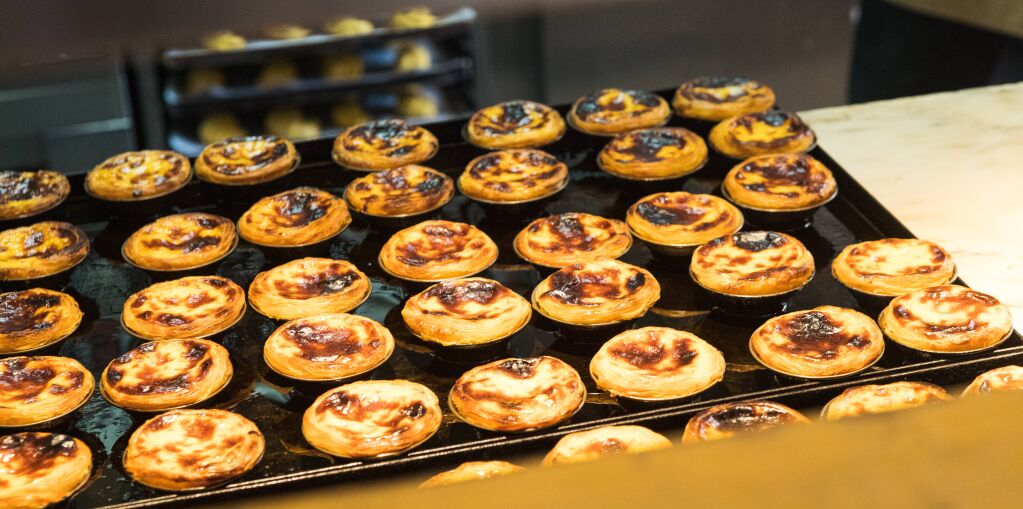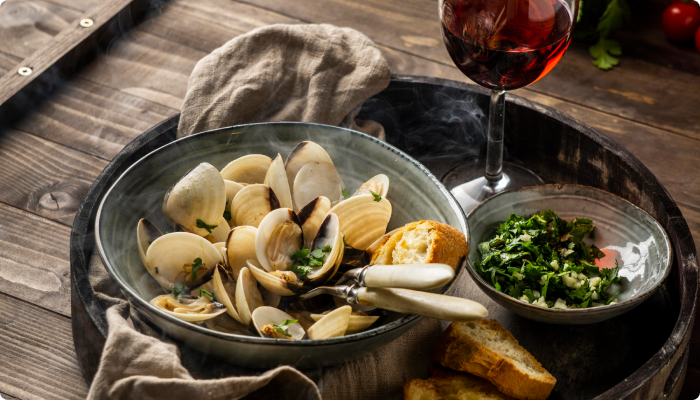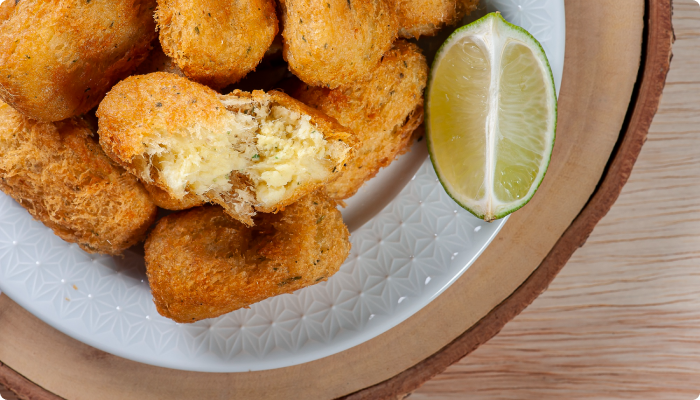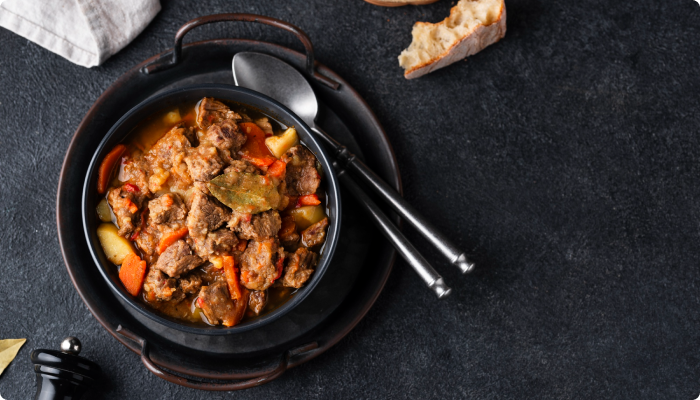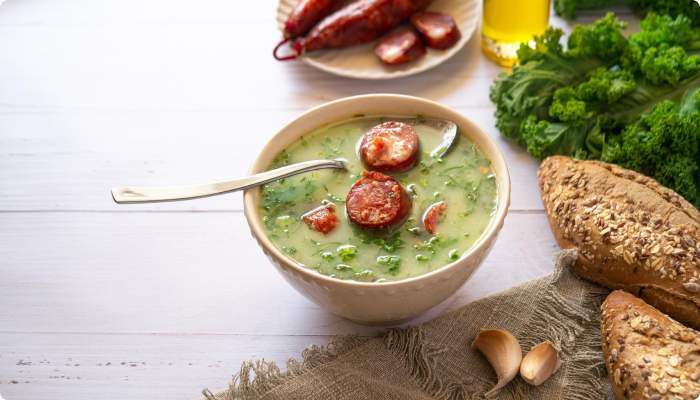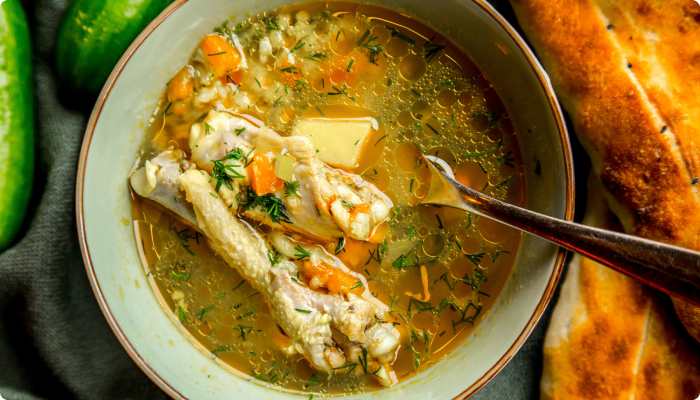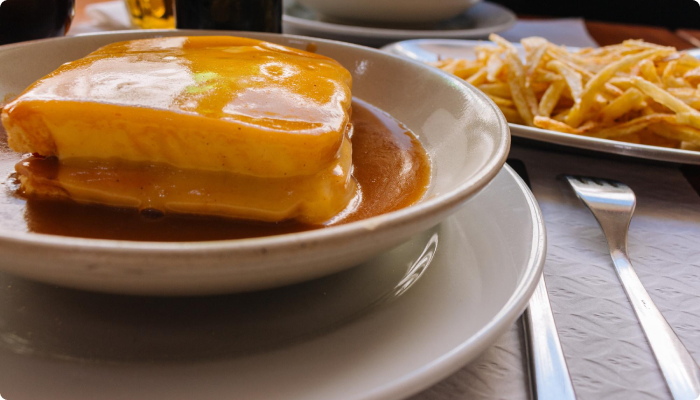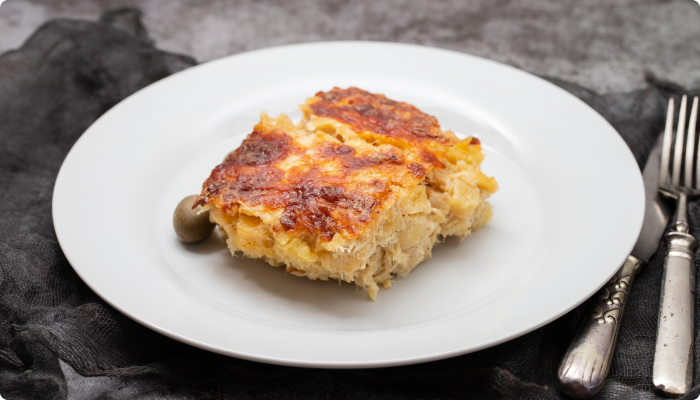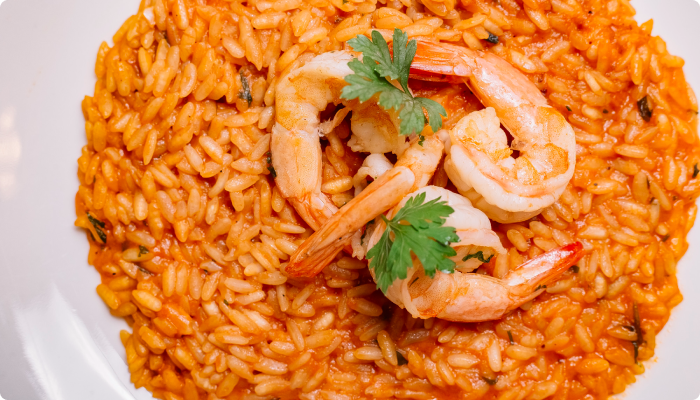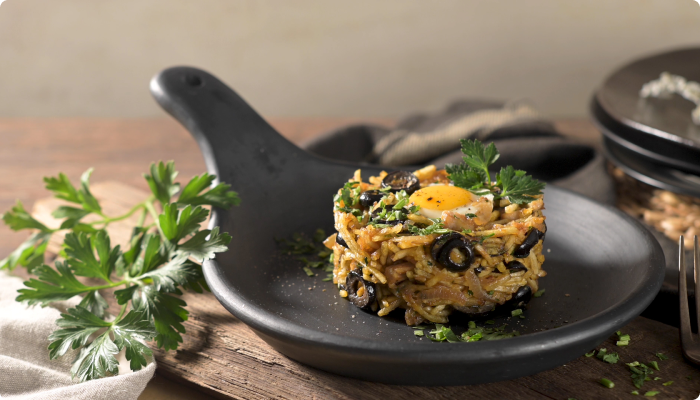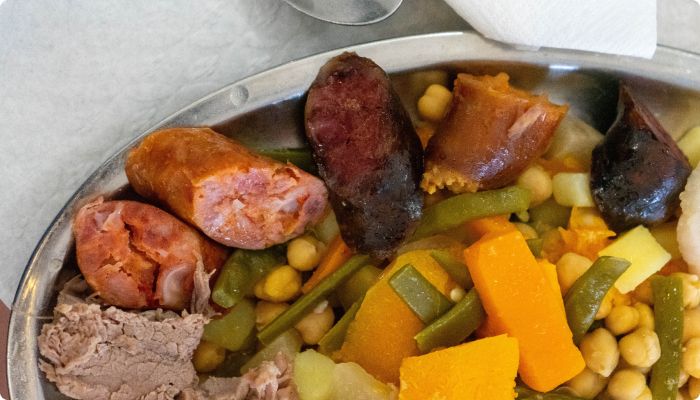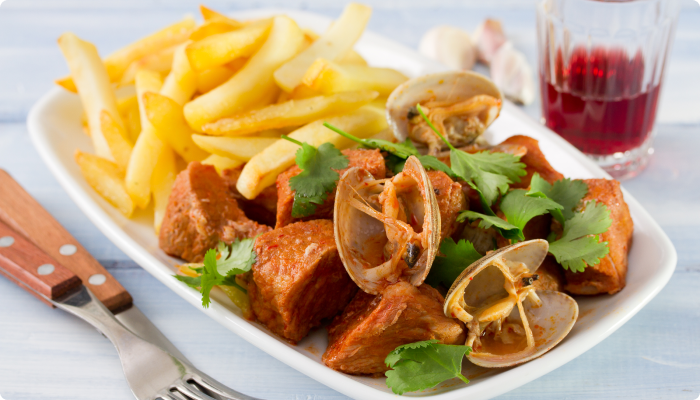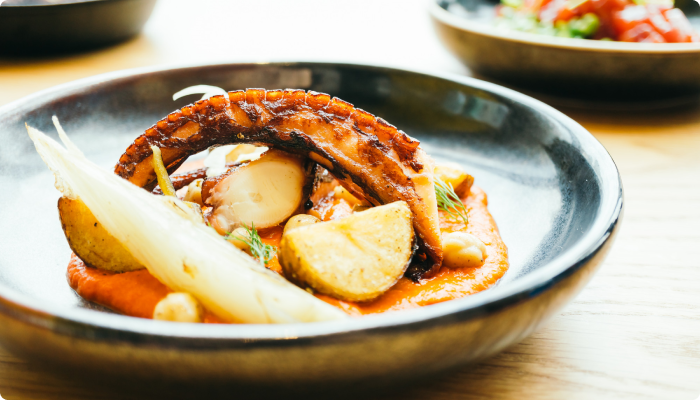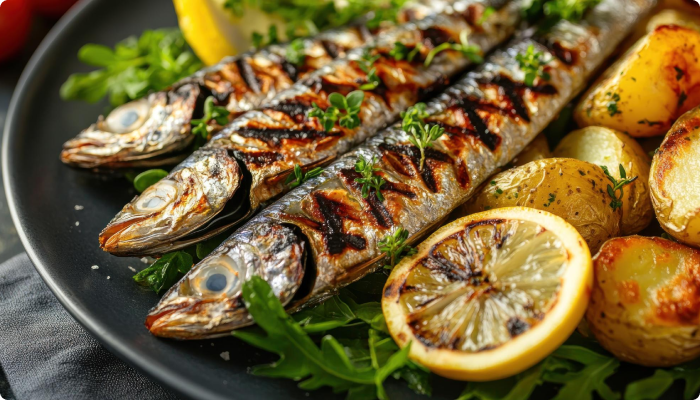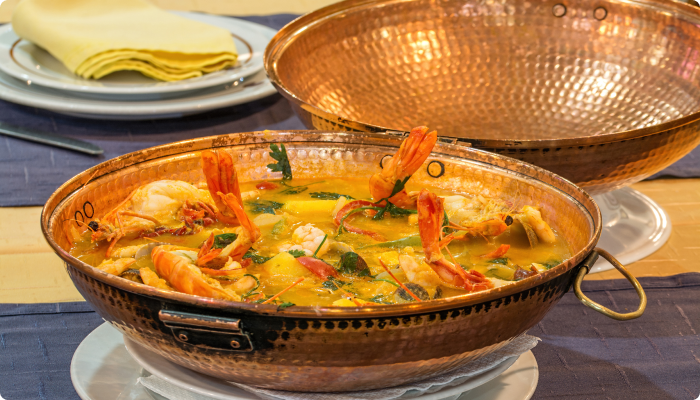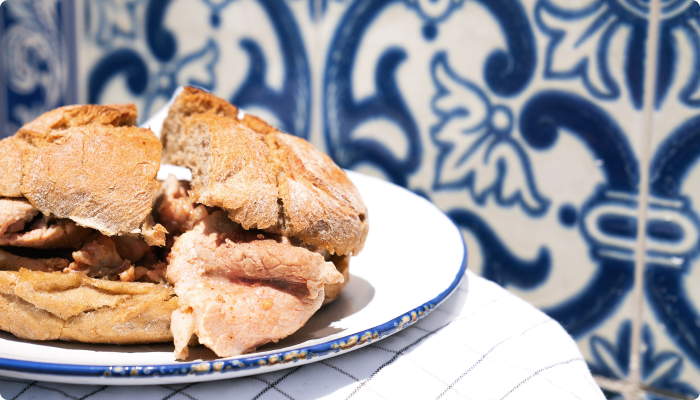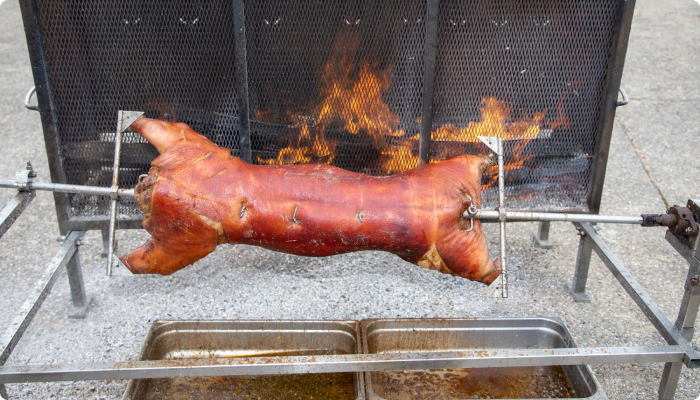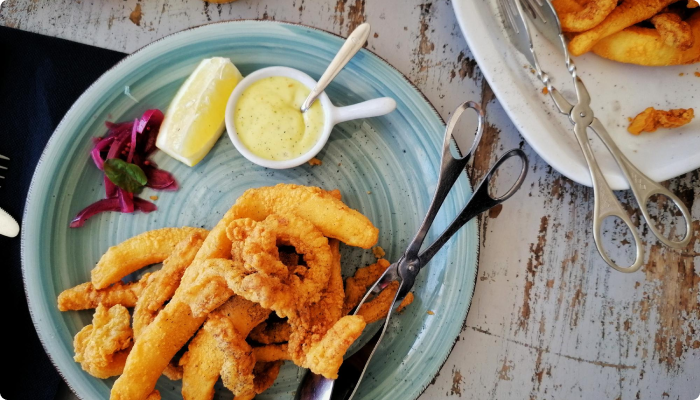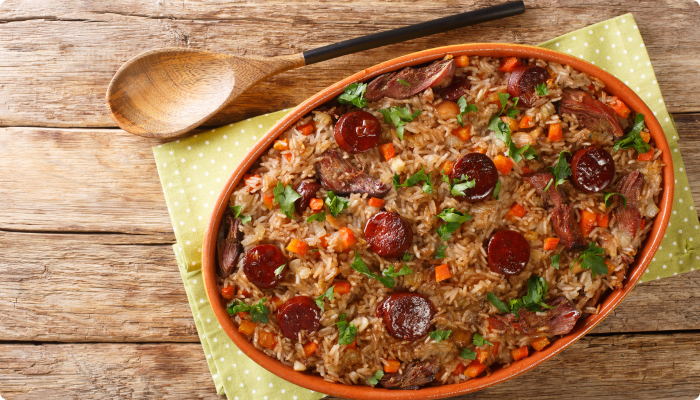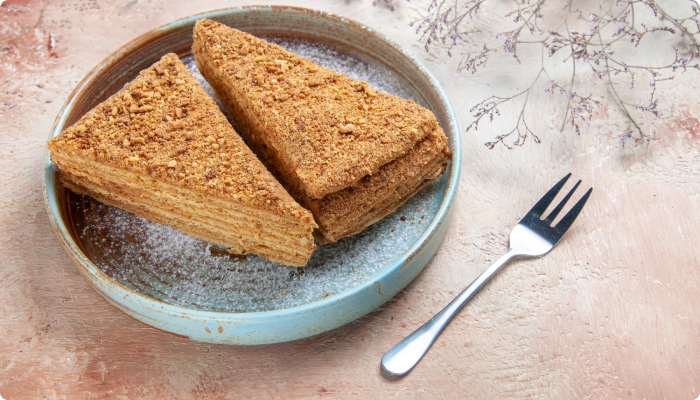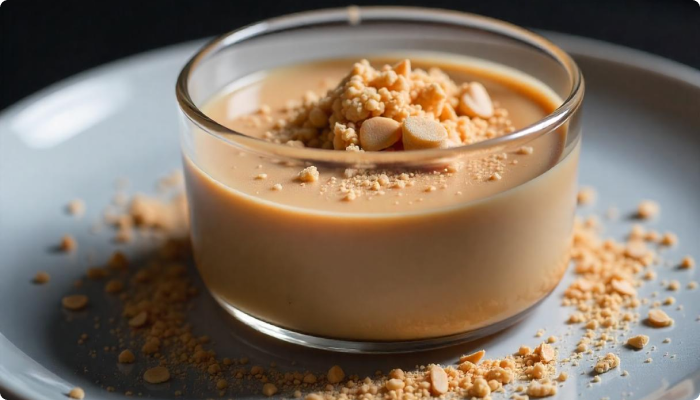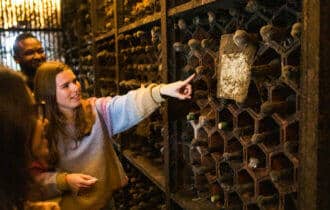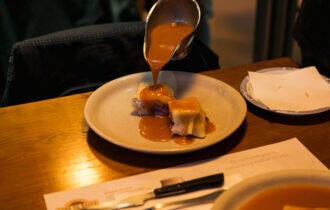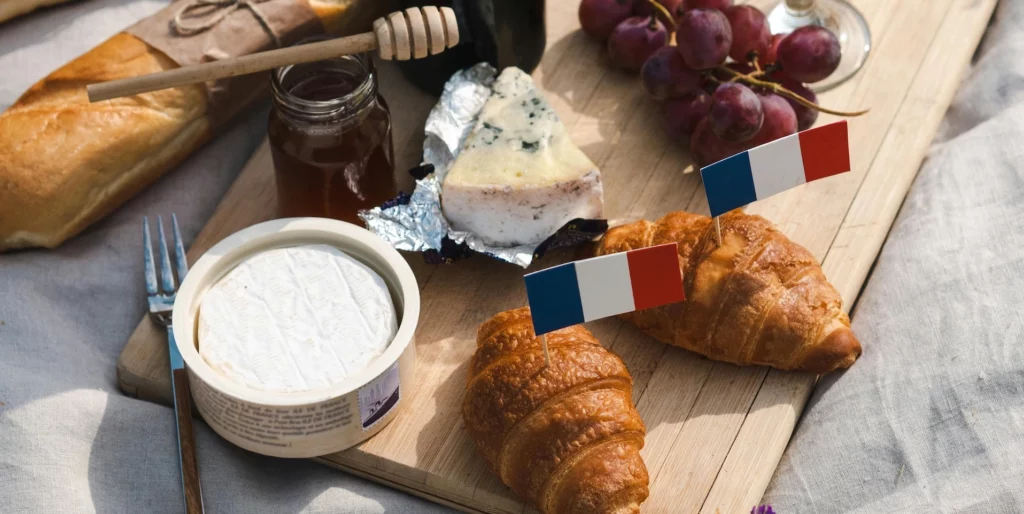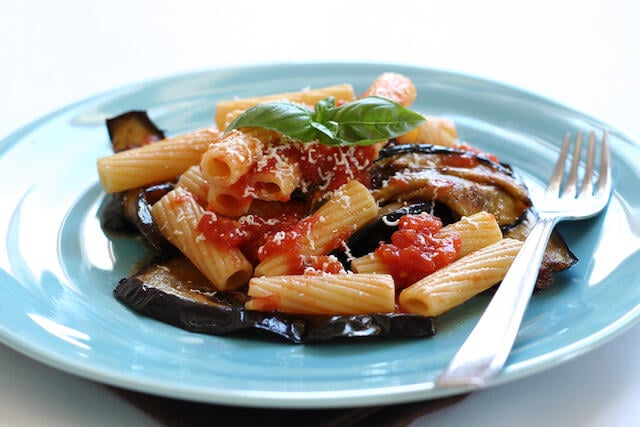In recent years, Portugal has begun making waves for its sensational culinary scene. Although it was previously overlooked by many in favor of French, Italian, or Spanish cuisine, the food in Portugal has become one of the country’s biggest selling points, and rightly so.
What I love most about Portuguese cuisine is its diversity, highlighted by the unique blend of regional ingredients and flavors. This is something I’ve tried to incorporate into my Portugal food tours, which feature everything from hearty stews to fresh seafood and fine wines.
If you have a trip to Portugal in the works and want to immerse yourself in the one-of-a-kind cuisine, this is the list for you. I’ve combined all of my favorite dishes to create this comprehensive guide to traditional dishes, regional delicacies, and delectable desserts!
Amêijoas à Bulhão Pato
A must-try food in Portugal for seafood fans, amêijoas à bulhão pato is a classic dish that involves adding a slew of vibrant ingredients to fresh clams.
Origin of Amêijoas à Bulhão Pato
Amêijoas à Bulhão Pato holds a special place in the history of Portuguese cuisine. Named after Bulhão Pato, a Lisbon-based poet with a deep appreciation for clams infused with garlic, cilantro, and lemon, this iconic dish has stood the test of time.
His preferred preparation method became so popular that his name is now forever linked to this beloved culinary tradition.
Key Ingredients
- Littleneck clams
- Garlic
- Cilantro
- Olive oil
- Lemon
Making the perfect amêijoas à bulhão pato means sticking to a simple, straightforward recipe.
How Amêijoas à Bulhão Pato Tastes
As far as refreshing, light dishes go, it doesn’t get much better than amêijoas à bulhão pato. Tender, minerally clams are a must, effortlessly soaking up the sharp lemon and grassy cilantro.
Where to Eat Amêijoas à Bulhão Pato
Out of all the places I’ve sampled amêijoas à bulhão pato, one spot that I can’t get enough of is Pinóquio in Lisbon. While normally, I wouldn’t be a massive fan of compact dining rooms, Pinóquio is the exception.
For over 30 years, these guys have been whipping up fine seafood-based dishes. It’s clear why, especially after trying their amêijoas à bulhão pato. From the soft sweetness of the clams to the garlicky kick of the sauce, even writing about it now makes me want to return for more.
Pinóquio (€€) – Praça dos Restauradores 79 80, 1250-188 Lisboa, Portugal – Open every day from 12:00 pm to 11:00 pm.
Amêijoas à Bulhão Pato’s Place In The Portuguese Course Structure
Amêijoas à Bulhão Pato is more than just a starter, it’s a taste of the sea, served as the perfect prelude to a Portuguese feast.
Wines That Can Be Paired With Amêijoas à Bulhão Pato
Alvarinho is my go-to whenever I’m tucking into these tasty clams, as the wine’s salinity and acidity complement the dishes’ bright flavors.
Pasteis de Bacalhau
Composed of some quintessential Portuguese ingredients, pasteis de bacalhau are fritters or croquettes stuffed with salted cod, parsley, and potatoes.
Origin of Pasteis de Bacalhau
Viana do Castelo is often regarded as the birthplace of pastéis de bacalhau, one of Portugal’s most iconic and beloved dishes. These crispy, golden codfish fritters became an integral part of the country’s culinary heritage in the 18th century when Queen Mary promoted potato cultivation. Over time, they evolved into a staple of Portuguese cuisine, enjoyed in homes, restaurants, and pastelarias across the nation.
Key Ingredients
- Salted cod
- Potatoes
- Onions
- Eggs
- Parsley
Just a handful of ingredients are needed to master the recipe for pasteis de bacalhau.
How Pasteis de Bacalhau Tastes
From the crackling exterior to the meaty mix of salted cod and fluffy potatoes, pasteis de bacalhau are comfort food at their finest. The peppery parsley and mild onions bring some extra flavor to every forkful.
Where to Eat Pasteis de Bacalhau
I’ve had my fair share of pasteis de bacalhau across Portugal, but nothing comes close to how they make them in Lisbon Tu e Eu. It’s a hole-in-the-wall kind of place that I nearly missed the first time I visited if not for the cute wooden tables out front.
To say the pasteis de bacalhau blew me away here would be putting it mildly. The saltiness of the cod paired with the crispy batter on the outside was a match made in heaven.
Lisbon Tu e Eu (€€) – R da Adiça 58, 1100-116 Lisboa, Portugal – Open every day from 12:30 pm to 10:00 pm.
Pasteis de Bacalhau’s Place In The Portuguese Course Structure
Pastéis de Bacalhau are a crispy, golden starter that kicks off a Portuguese meal with rich, savory flavor.
Wines That Can Be Paired With Pasteis de Bacalhau
Vinho verde is a lovely accompaniment to a serving of pasteis de bacalhau. The wine’s zingy nature balances the dish’s gentle seafood flavors.
Pica Pau
Pica pau is a much-loved snack in Portugal. At its core, it’s a serving of beef chunks marinated in a mish-mash of ingredients like beer, wine, and mustard.
Origin of Pica Pau
For decades now, pica pau has been a staple in many of Lisbon’s tascas, and is often seen as an ideal dish to enjoy with an alcoholic drink. Its name, which translates to ‘woodpecker’ in English, playfully refers to the way diners use toothpicks to pick up each delicious morsel. Over time, pica pau has become a must-try petisco, embodying the lively and communal spirit of Portuguese dining culture.
Key Ingredients
- Sliced beef strips
- Beer or white wine
- Garlic
- Mustard
- Chilis or piri piri
- Olive oil
- Bay leaf
- Pickles (garnish)
- Olives (garnish)
Most recipes offer some flexibility based on how spicy you want your pica pau to come out.
How Pica Pau Tastes
Though the recipe can vary between establishments, the beef in pica pau tends to have tangy, savory flavors, elevated by the hint of spice from the mustard and chilis.
Where to Eat Pica Pau
In an establishment with pica pau in its name, you can bet their take on this specialty is going to be good. Restaurante Pica-Pau offers the perfect mix of age-old cooking traditions with modern interiors.
At first glance, the pica-pau may look on the smaller side, but the explosive spicy flavors from the gravy blended with the juices from the succulent beef are enough to fill a gap before your main course arrives.
Restaurante Pica-Pau (€€) – R. da Escola Politécnica 27, 1200-244 Lisboa, Portugal – Open every Monday to Thursday from 12:00 pm to 4:00 pm and from 7:00 pm to 12:00 am, Friday from 12:00 pm to 4:00 pm and from 7:00 pm to 1:00 am, Saturday from 12:00 pm to 1:00 am, and every Sunday from 12:00 pm to 12:00 am.
Pica Pau’s Place In The Portuguese Course Structure
Wines That Can Be Paired With Pica Pau
Many locals choose to team pica pau with beer, but it also works well with dry white wines, as their herbaceous tones stand up to the dish’s robust flavors.
Caldo Verde
In the structure of Portuguese meals, caldo verde is mostly seen as a soup. However, if you’ve been on my Porto food tours, you’ll know that this potato, sausage, and veggie-filled concoction could easily stand as a meal on its own!
Origin of Caldo Verde
Braga in northern Portugal is where caldo verde gained prominence. This comforting and wholesome soup has been a cherished part of Portuguese cuisine for centuries, dating back to at least the 15th century. Though the recipe has evolved over time, its essence remains rooted in simplicity. Today, it is enjoyed across Portugal, from rustic village kitchens to elegant city restaurants, as a beloved dish that embodies the warmth and tradition of Portuguese home cooking.
Key Ingredients
- Potatoes
- Onions
- Garlic
- Sliced sausage
- Kale
- Olive oil
Try this wholesome soup for yourself with this easy-to-follow recipe.
How Caldo Verde Tastes
Fork-tender potatoes are at the heart of this dish. They bring thickness to the soup but also work to soften the bitter kale and piquant sausage.
Where to Eat Caldo Verde
Braga’s esteemed Dona Petisca is hard to top when it comes to a good old bowl of caldo verde. The soft-toned bricked walls, complemented with pendant lighting and towering liquor cabinets, make this eatery a delight to eat in.
Normally, caldo verde in a restaurant can be hit or miss because it’s more of a homely meal, but the chefs at Dona Petisca have nailed it: the warm, earthy richness from the soup mixed excellently with the smokiness from the chorizo.
Dona Petisca (€) – R. Dom Paio Mendes 59, 4700-424 Braga, Portugal – Closed every Monday, open Tuesday to Thursday from 12:00 pm to 12:00 am, Friday and Saturday from 12:00 pm to 2:00 am, and every Sunday from 4:00 pm to 12:00 am.
Caldo Verde’s Place In The Portuguese Course Structure
Caldo verde is a type of soup, usually served at the beginning of a meal.
Canja de Galinha
Canja de Galinha is a Portuguese chicken soup that can feature a varying line-up of vegetables and herbs, though the result is always a nourishing, aromatic dish.
Origin of Canja de Galinha
Canja de Galinha has a rich and debated history. Some trace its origins to the Azores, where it became a staple of local cuisine. However, it’s likely that a version of this dish arrived from Asia, brought back by Portuguese explorers during their voyages. Widely known for its comforting and nourishing qualities, Canja de Galinha became a go-to remedy for colds and a cherished home-cooked meal across Portugal and its former colonies.
Key Ingredients
- Skinless chicken breasts
- Potatoes
- Pasta
- Onions
- Carrots
- Garlic
- Olive oil
- Mint
- Thyme
Many recipes call for mint, but this can be substituted for other flavorings.
How Canja de Galinha Tastes
The use of chicken, potatoes, and pasta gives this soup a rather neutral base, and the infusion of cool mint and citrusy thyme lightened the dish’s heavy nature.
Where to Eat Canja de Galinha
I’ve long been a fan of Galeto in Lisbon since I discovered their bar-style dining experience, and when I tried their canjade galinha, I was hooked. You won’t find your typical face-to-face settings here; it’s more of a vintage setting where customers sit at the bar.
After ordering the ganja de galinha based on the server’s recommendation, I wasn’t sure what to expect. However, I was pleasantly surprised; the thick chicken broth had an egginess to it with a slight zesty aftertaste.
Galeto (€€) – Av. da República 14, 1050-191 Lisboa, Portugal – Open every day from 7:30 am to 3:30 am.
Canja de Galinha’s Place In The Portuguese Course Structure
Canja de Galinha is a comforting, soul-warming soup, traditionally served as a soothing start to a Portuguese meal.
Francesinha
A highlight for many on my progressive dinner Porto food tours, francesinha is a traditional Portuguese dish you’ve likely heard all about. Simply put, it’s a sizable sandwich encompassing multiple meats, cheese, and generous amounts of spiced sauce.
Origin of Francesinha
Francesinha, one of Porto’s most famous culinary creations, was invented by Daniel David de Silva, a Porto-born chef with a passion for bold flavors. After spending time in France, he was inspired by the classic croque monsieur but wanted to give it a distinctly Portuguese twist. Upon his return, he reimagined the sandwich by layering cured meats, steak, and melted cheese, then drenching it in a rich, flavorful beer-based sauce. Over time, the Francesinha became a beloved dish in Porto, celebrated for its indulgent, hearty nature and best enjoyed with a side of crispy fries and a cold beer.
Key Ingredients
- Steak
- Sausage (such as linguiça)
- Ham
- Bread
- Egg
- Cheese
- Beer
- Port wine
- Beef broth
- Tomatoes
- Onions
- Garlic
In most traditional recipes, you’ll likely notice some variances in the exact ingredients used.
How Francesinha Tastes
The late Anthony Bourdain described francesinha perfectly, ‘meat, cheese, fat, bread: It’s the immortal combination.’ I can’t think of a more apt way to describe this ultra-filling, meaty dish and its velvety hot sauce!
Where to Eat Francesinha
Santiago da Praça’s reputation for its delicious francesinha should not be understated. After hearing so many people rave about this spot, I finally bit the bullet and tried it the last time I visited Porto. The gorgeous black-and-white wallpaper and light-filled dining area made the already scrumptious meal even more enjoyable.
I was lucky I came here hungry to try this traditional Portuguese sandwich. Between the huge portion size and the oozing layers of creamy cheese melted into the salty, umami-rich sausage, it was one heck of a feast, to say the least.
Santiago da Praça (€) – Praça dos Poveiros 82, 4000-041 Porto, Portugal – Open every Monday to Saturday from 12:00 pm to 11:00 pm, closed every Sunday.
Francesinha’s Place In The Portuguese Course Structure
Francesinha is a hearty, sauce-drenched masterpiece, served as a main course and guaranteed to satisfy even the biggest appetite.
Wines That Can Be Paired With Francesinha
A douro tinto is a reliable choice when it comes to francesinha. It’s bold enough to hold its own against the flavors of the sandwich, yet it doesn’t feel too heavy or overpowering.
Bacalhau com Natas
The Portuguese have had an affinity for salted cod for centuries, and bacalhau com natas is among the best examples of how it can be utilized to make a filling main course. In this dish, the cod is interspersed with layers of potatoes, cream, and onions.
Origin of Bacalhau com Natas
Bacalhau com Natas (cod with cream) is a relatively modern take on Portugal’s beloved salted cod dishes. Unlike traditional recipes that date back centuries, this creamy and indulgent dish is believed to have originated in the 20th century, likely in Lisbon. While its exact creator is unknown, the dish emerged as a more contemporary adaptation of Portugal’s many bacalhau-based meals, incorporating dairy—a less common ingredient in older Portuguese cuisine.
Key Ingredients
- Salted cod
- Potatoes
- Onions
- Garlic
- Fresh cream
- Flour
- Butter
- Milk
- Cheese
- Nutmeg
- Parsley
Recreate this flavorful dish at home with this detailed recipe.
How Bacalhau com Natas Tastes
Bacalhau com natas has a reputation for being oh-so-creamy and decadent. Still, it rarely gets enough credit for how it incorporates livelier flavors like warm nutmeg and clean parsley.
Where to Eat Bacalhau com Natas
A must-try location for bacalhau com natas in Lisbon is the Casa do Bachalau. Not only is their take on this famous dish seriously good, but the décor is ultra-plush. As it’s set in an old mansion, you’d be forgiven for thinking you’re inside an underground cave.
No other dish here comes close to the bacalhau com natas. The saltiness of the cod melded just right with the creamy potatoes, and the satisfying crunch that the toasted top layer provided really made this one stand out for me.
Casa do Bacalhau (€€) – Rua do Grilo 54, 1900-706 Lisboa, Portugal – Open every day from 12:00 pm to 11:00 pm.
Bacalhau com Natas’s Place In The Portuguese Course Structure
Bacalhau com Natas is a rich and creamy delight, taking center stage as a comforting main course in Portuguese cuisine.
Wines That Can Be Paired With Bacalhau com Natas
I like to pair a serving of bacalhau com natas with vinho verde because of the fruity, citrus notes that come with every sip; it also balances out the saltiness of the dish.
Arroz de Marisco
In terms of seasonal Portuguese specialties, it’s tough to argue there’s a better dish than arroz de marisco. This seafood rice is at its best during springtime when fresh catches are abundant.
Origin of Arroz de Marisco
Arroz de Marisco does not have a single definitive point of origin but rather emerged from Portugal’s coastal fishing communities, where seafood was abundant, and simple, hearty meals were a necessity. While Praia da Vieira is closely associated with the dish, similar seafood rice recipes were also developed in other coastal regions, particularly in the Algarve and Estremadura.
Key Ingredients
- Prawns
- Clams
- Mussels
- Tomatoes
- Peppers
- Onions
- Garlic
- Chili
- Long-grain rice
Choose an assortment of seafood of your choice to customize your recipe.
How Arroz de Marisco Tastes
This dish has a little bit of everything in the flavor department. The seafood brings buttery salinity to the table that’s absorbed into the zesty vegetables and sticky rice.
Where to Eat Arroz de Marisco
I’ve been to quite a few Portuguese food establishments during my time in the Algarve region, but one that sticks with me for its arroz de marisco is Marisqueira Rui. With its checkered curtains and white-clothed wooden tables, the place has the charm of a large communal area where everyone comes for a big family dinner.
As soon as I saw the server coming with the large bowl, I knew I was in for a treat. This rice-based stew had a mind-blowing fusion of flavors; it was boldly briny with just the right hint of zingyness from the tomato sauce.
Marisqueira Rui (€€) – R. Comendador Vilarinho 27, 8300-148 Silves, Portugal – Open every Monday and Wednesday to Sunday from 12:00 pm to 4:00 pm and from 6:00 pm to 11:00 pm, closed every Tuesday.
Arroz de Marisco’s Place In The Portuguese Course Structure
Arroz de Marisco is a vibrant, ocean-infused masterpiece, served as a main course that brings the flavors of the sea straight to the table.
Wines That Can Be Paired With Arroz de Marisco
While vino verde goes well with arroz de marisco, I prefer to have it with alvarinho as the wine’s acidity provides a nice balance to the overall sweetness of the seafood.
Bacalhau à Brás
A favorite of legendary Portuguese chef José Avillez, bacalhau à brás is yet another innovative way to prepare salted cod and potatoes and is a key feature on my Lisbon food and wine tours. Both elements are shredded and mixed with eggs and onions.
Origin of Bacalhau à Brás
The origins of many bacalhau-based dishes are difficult to trace, but there is some evidence suggesting that this particular recipe emerged in Lisbon’s Bairro Alto neighborhood. According to local stories, a chef named Blaz is credited with creating the dish as a way to repurpose leftovers from his restaurant, turning simple ingredients into a flavorful and satisfying meal. Over time, this humble yet inventive dish became a beloved staple in Portuguese cuisine, celebrated for its rich flavors and resourceful approach to cooking.
Key Ingredients
- Salted cod
- Potatoes
- Eggs
- Onions
- Parsley
- Olive oil
- Bay leaf
A host of classic Portuguese ingredients are used in bacalhau à brás recipes.
How Bacalhau à Brás Tastes
Bacalhau à brás boasts a dynamic mix of tastes and textures, from the crisped potatoes and gooey egg to the umami onions and savory cod.
Where to Eat Bacalhau à Brás
The people of Lisbon have hailed Laurentina for decades for its cod-based dishes, and one of them I had the pleasure of trying recently was the bacalhau à brás. Simple yet inviting aesthetics with some of the friendliest staff, every foodie should have this place on their wishlist.
Served in a neat little mountain, each bite had a gentle sweetness from the onions with just the right touch of saltiness and a velvety texture brought by the eggs.
Laurentina (€€) – Av. Conde Valbom 71A, 1050-067 Lisboa, Portugal – Open every Monday to Saturday from 12:00 pm to 4:00 pm and from 7:00 pm to 11:00 pm, closed every Sunday.
Bacalhau à Brás’ Place In The Portuguese Course Structure
Bacalhau à brás is a prato principal, meaning it’s a main course.
Wines That Can Be Paired With Bacalhau à Brás
A few wines match well with bacalhau à brás, but one I recommend you try is Alvarinho for its bright acidity that balances the dish’s richness.
Cozido à Portuguesa
When you strip it back, cozido à Portuguesa is an old-school stew that works with pretty much any selection of meat and veggies.
Origin of Cozido à Portuguesa
Like many traditional stews, Cozido à Portuguesa originated as a way for working-class communities to make use of whatever affordable ingredients were available. This hearty dish is closely linked to regions such as Guarda and Beira, where people adapted the recipe based on local meats, vegetables, and seasonings. Over time, countless regional variations have developed, each reflecting the unique culinary traditions and resources of different parts of Portugal, making it one of the country’s most beloved comfort foods.
Key Ingredients
- Beef (e.g., brisket or chuck)
- Pork (ribs, shoulder, or ear)
- Chicken (often whole or large pieces)
- Pork belly or bacon
- Chouriço (smoked paprika sausage)
- Morcela (blood sausage)
- Farinheira (smoked flour sausage)
- Cabbage (often savoy or green)
- Carrots
- Potatoes
- Olive oil
- Salt and pepper
This is the kind of recipe that allows you to utilize whatever meat and vegetables you have on hand.
How Cozido à Portuguesa Tastes
The specific ingredients will determine the taste of the dish. In general, though, it’s a dreamy blend of smokey, beefy, earthy, and sweet notes with a chunky consistency.
Where to Eat Cozido à Portuguesa
O Rápido, just down the street from the Church of Saint Ildefonso in Porto, is my favorite stop for a serving of cozido à portuguesa. While the restaurant is on the smaller side, that adds to its allure, as does the beautiful wall art surrounding the dining room.
Every spoonful of the cozido à portuguesa was a rollercoaster of flavors, with the fiery spiced sausage, tender beef, and an element of earthiness from the veggies.
O Rápido (€€) – R. da Madeira 194, 4000-330 Porto, Portugal – Open every Monday from 12:00 pm to 3:30 pm, Tuesday to Saturday from 12:00 pm to 3:00 pm and from 7:30 pm to 10:00 pm, closed every Sunday.
Cozido à Portuguesa’s Place In The Portuguese Course Structure
Given the rich and full-bodied character of Esporão wine, it pairs well with a dish like Cozido à Portuguesa, especially when there are plenty of vegetables, as its depth helps balance the earthy flavors.
Carne de Porco à Alentejana
A unique but traditional Portuguese dish, carne de porco à alentejana, is made from clams and pork pieces, highlighting the country’s coastal and inland delicacies.
Origin of Carne de Porco à Alentejana
Carne de Porco à Alentejana is a traditional Portuguese dish that originates from the Alentejo region in southern Portugal. Despite its name, which translates to “Alentejo-style pork” the dish is notable for combining two regional elements: marinated pork from Alentejo and clams, typically associated with the coastal Algarve region.
While the exact origin is debated, the dish symbolizes the blending of inland and coastal flavors and has become one of Portugal’s most iconic recipes.
Key Ingredients
- Pork shoulder
- Littleneck clams
- Potatoes
- Onions
- Garlic
- Cilantro
- White wine
- Olives
This classic recipe is packed with flavor and hearty ingredients.
How Carne de Porco à Alentejana Tastes
Just as you’d expect, the dish has both fatty pork notes and a hint of minerality from the clams, and these contrasting flavors come together surprisingly well.
Where to Eat Carne de Porco à Alentejana
Ask any in-the-know culinary expert where to try carne de porco à alentejana, and they’re going to send you straight to Pátio Alentejano. If you were to walk by this eatery on a normal day, you wouldn’t think it looked like anything special. However, behind the walls lies a spacious, tiered restaurant surrounded by different cases of wine.
After coming here a handful of times, I can say with confidence that it’s worth visiting just for the carne de porco à alentejana. The refreshing burst of cilantro was a nice finishing touch to the pork’s natural sweetness and the clams’ salty depth.
Pátio Alentejano (€€) – R. do Pinhal 4, 7645-293 Vila Nova de Milfontes, Portugal – Open every Monday to Wednesday and Saturday to Sunday from 12:00 pm to 3:00 pm and from 7:00 pm to 11:00 pm, Friday from 6:30 pm to 11:00 pm, closed every Thursday.
Carne de Porco à Alentejana’s Place In The Portuguese Course Structure
Carne de Porco à Alentejana is a star of the table, a rich and satisfying main course that perfectly blends the flavors of land and sea.
Wines That Can Be Paired With Carne de Porco à Alentejana
Rosés work best with clams and pork together. They have just enough acidity to balance the sweetness from the clams while also bringing a nice level of fruitiness that enhances the flavors of the pork.
Polvo à Lagareiro
If you’re a fan of seafood in Portugal, you’ll love polvo à lagareiro, which consists of fresh octopus baked in a medley of potatoes, garlic, and olive oil.
Origin of Polvo à Lagareiro
While Polvo à Lagareiro is enjoyed throughout Portugal, its origins are more closely tied to the northern regions like Minho and Trás-os-Montes, known for their olive oil production and rustic cooking traditions.
However, the Algarve—Portugal’s southern coastal region—has a strong tradition of octopus fishing and cuisine, particularly in towns like Santa Luzia, often called the “Octopus Capital” of Portugal.
Key Ingredients
- Octopus
- Potatoes
- Garlic
- Olive oil
- Bay leaf
Just a few ingredients are needed for this dish, with most recipes highlighting some complementary spices.
How Polvo à Lagareiro Tastes
This dish is all about refined flavors. At the center is the mellow, slightly chewy octopus, which takes on the nuttiness of the garlic and floral undertones of the olive oil.
Where to Eat Polvo à Lagareiro
It’s not hard to find good seafood in Santa Luzia, but the dedication to octopus at Casa do Polvo Tasquinha makes it truly special. I fell in love with this spot from the moment I walked in, with its cozy, rustic decor and a menu that celebrates octopus in every way imaginable.
Where do I begin with the polvo à lagareiro? Every bite was a divine combination of garlicky and salty flavors mixed in with a strong oceanic punch from the octopus.
Casa do Polvo Tasquinha (€€) – Av. Eng. Duarte Pacheco 8, 8800-545 Santa Luzia – Open Wednesday to Sunday from 12:00 PM to 2:45 PM and 6:30 PM to 9:45 PM, Monday is open from 12:00 PM to 2:45 PM. Closed on Tuesday.
Polvo à Lagareiro’s Place In The Portuguese Course Structure
Polvo à Lagareiro is a showstopping main course, where tender octopus meets golden, garlicky olive oil for a truly unforgettable dish.
Wines That Can Be Paired With Polvo à Lagareiro
Consider a glass of Soalheiro Alvarinho to enjoy with your Polvo à Lagareiro. Its bright acidity and citrus notes complement the rich, tender octopus, enhancing each bite with a refreshing contrast.”
Sardinhas Assadas
Sardinhas assadas is a wonderful example of regional Portuguese cuisine and a source of pride for Lisbon natives. All this dish needs is quality grilled sardines and a clutch of seasoning.
Origin of Sardinhas Assadas
Sardinhas Assadas (grilled sardines) are a traditional Portuguese dish with deep cultural and historical roots, especially along Portugal’s Atlantic coast.
The dish is especially iconic during the Festas de Lisboa in June, where grilled sardines are enjoyed in the streets as part of the celebration of Santo António, Lisbon’s patron saint.
Key Ingredients
- Sardines
- Olive oil
- Salt
- Lemon
The perfect sardinhas assadas recipe requires just a few components.
How Sardinhas Assadas Tastes
The succulent texture and briny flavor of these sardines are exquisite, but just a touch of sour lemon and fruity olive oil take this dish up a notch.
Where to Eat Sardinhas Assadas
You’ll find a bunch of bustling Portuguese food establishments by the Tagus in Lisbon, but Último Porto stands out for its no-frills, authentic charm. Tucked away near the docks, this spot is all about simplicity—communal tables, a relaxed atmosphere, and the irresistible aroma of freshly grilled seafood filling the air
I could tell the sardinhas assadas were grilled over an open flame; they were tender and oh-so flaky, with a charred undertone. The lemon served on the side added a citrusy burst that intensified the flavor.
Último Porto (€€) – Open every Monday to Saturday from 12:00 pm to 4:00 pm, closed on Sunday.
Sardinhas Assadas’s Place In The Portuguese Course Structure
Wines That Can Be Paired With Sardinhas Assadas
I love pairing Soalheiro Vinho Verde with sardinhas assadas. Its bright acidity and slight effervescence cut perfectly through the richness of the grilled sardines, while the fresh citrus notes bring out the smoky flavors. It’s one of those simple, authentic pairings that feels just right on a warm day in Lisbon.
Cataplana
Cataplana is another traditional Portuguese dish that doesn’t have a strict recipe. I’ve tried this seafood stew countless times, and each time, it’s been slightly different.
Origin of Cataplana
Cataplana is a signature dish of the Algarve, known for its rich flavors and unique cooking method. While its exact origins remain uncertain, many believe the dish was influenced by the Moorish community, who arrived in Portugal during the 8th century. The cataplana cooking vessel, a hinged metal pot that seals in flavors, is thought to have Moorish roots, resembling the cookware used in North African cuisine.
Key Ingredients
- Selection of seafood (prawns, lobster, clams, mussels, white fish)
- Crushed tomatoes
- Bell peppers
- Onions
- Garlic
- White wine
- Olive oil
Make this recipe your own with your favorite seafood varieties.
How Cataplana Tastes
Cataplana really does have it all: delicate fish, aromatic vegetables, and a fragrant sauce.
Where to Eat Cataplana
When you get to Albufeira, one establishment you’ll hear everyone talking about is Restaurante O Catraio. After my buddy and I arrived for our reservation, we knew we were in for a true feast. We loved the social dining setup with everyone sitting next to each other, and the lovely music in the background was a nice touch.
The cataplana we ordered was meant for sharing between two people. It wasn’t too big, which was welcomed since I wasn’t overly hungry. However, it was loaded with seafood, particularly prawns that had light, sweet undertones, which combined pleasantly with the almost stewed tomato base.
Restaurante O Catraio (€€) – R. 5 de Outubro 75, 8200-094 Albufeira, Portugal – Open every Monday to Saturday from 12:00 pm to 10:00 pm, closed every Sunday.
Cataplana’s Place In The Portuguese Course Structure
Wines That Can Be Paired With Cataplana
When pairing cataplana, vinho verde is a reliable option thanks to its citrusy profile that pairs well with the seafood’s fresh, oceanic taste.
Bifana
Gordan Ramsay dubbed bifana ‘one of the best pork sandwiches anywhere in the world,’ and most people on my Tuk Tuk Lisbon food tours would probably agree!
Origin of Bifana
The city of Évora, located in the heart of Portugal’s Alentejo region, is widely recognized as the birthplace of the bifana, one of the country’s most iconic sandwiches. While it’s generally accepted that the bifana originated here, the exact details of its creation remain unclear. Despite the mystery surrounding its backstory, this simple yet flavorful pork sandwich has become a beloved staple across Portugal, with regional variations that showcase different bread types, seasonings, and cooking techniques.
Key Ingredients
- Sliced pork
- Onions
- Garlic
- White wine
- Paprika
- Pimenta
- Bread Roll
Make your bifana as hot or mild as you like with this recipe.
How Bifana Tastes
The perfect bifana mixes crusty bread, thin strips of spicy pork, and thick, garlicky sauce.
Where to Eat Bifana
If you’re in Vendas Novas, Café Boavista is the place to go for the real deal.. Don’t expect anything fancy, this is a fast-paced, no-frills spot where locals line up for their perfectly seasoned, juicy bifanas, best enjoyed with a cold beer.
I usually have something to critique about most dishes I try, but not the bifana here. A combination of garlic-drenched sliced pork steak smothered in a rich layer of cheese and wrapped in a warm bun, I was astounded something so simple could taste this good.
Café Boavista (€) – R. da Boavista 66, Vendas Novas – Open every Tuesday to Sunday from 7:00 am to 11:30 pm. Closed every Monday
Bifana’s Place In The Portuguese Course Structure
Bifana is a prato principal, meaning it’s a main course.
Wines That Can Be Paired With Bifana
I prefer pairing bifana with a red, like touriga nacional, which offers a subtle spice and a blackcurrant-like flavor that complements the pork. That said, a cold beer is also a perfect match, balancing the sandwich’s garlicky, slightly spicy notes with its refreshing crispness.
Piri Piri Chicken
An instantly recognizable food in Portugal, piri piri chicken has won the world over. Piri piri is a spice blend that’s typically used as a marinade for juicy cuts of chicken.
Origin of Piri Piri Chicken
Many people associate piri piri chicken with the Algarve, where it has become a popular dish, but its true homeland is Mozambique, a former Portuguese colony in Africa. The dish’s roots trace back to the 16th century, when Portuguese explorers encountered the African bird’s eye chili, also known as piri piri. Over time, Mozambican cooks blended local ingredients with Portuguese culinary influences, creating the now-famous spicy marinade. When Portugal colonized Mozambique, the dish traveled back to the mainland, eventually becoming a national favorite, particularly in the Algarve, where it is now a staple of local cuisine.
Key Ingredients
- Chicken
- Lemon
- Chili
- Paprika
- Black pepper
- Olive oil
Craft the most delicious marinade for piri piri chicken with this recipe.
How Piri Piri Chicken Tastes
Piri piri chicken gets the balance of smokey, salty, and fiery flavors just right as the spices merge with the meaty juices.
Where to Eat Piri Piri Chicken
Very few establishments can deliver piri piri chicken that’s as yummy as Piripiri D’Almancil. The outdoor patio is where the buzz is here; they’ve got a live musician playing in the evenings, and the lush greenery surrounding the area adds a layer of privacy.
This was some of the juiciest chicken I’ve ever had. With every bite, each piece fell apart in my mouth, and the crispy, lightly spiced skin a little heat.
Piripiri D’Almancil (€€) – Estr. Vale Formoso 1, 8135-148 Almancil, Portugal – Open every Monday to Saturday from 12:00 pm to 3:00 pm and from 6:00 pm to 10:00 pm and every Sunday from 6:00 pm to 10:00 pm.
Piri Piri Chicken’s Place In The Portuguese Course Structure
Wines That Can Be Paired With Piri Piri Chicken
Given that Piri Piri Chicken has so much flavor, the last thing you want to do is overpower it. That’s why I recommend a Touriga Nacional from Dão, as its smooth tannins and dark fruit notes complement the smoky spice without overwhelming the dish.
Leitão
Portugal’s version of sucking pig, leitao involves roasting the meat with a particular set of flavorings, namely garlic and olive oil.
Origin of Leitão
Key Ingredients
- Suckling pig
- Garlic
- Bay leaf
- Olive oil
- Salt
- Pepper
This leitão recipe will leave you with the most mouthwatering meat.
How Leitão Tastes
Leitão is known for its intensely flavorful nature. On the outside is crunchy, honey-like skin that encases soft, deeply savory meat.
Where to Eat Leitão
It’s easy to understand why Aldeia do Leitão gets all the praise for its leitão in Boa Vista. Besides its striking indoor aesthetics and mix of hues, its suckling pig recipe is truly exceptional.
Chopped into little pieces and served on a metal tray, I could smell the garlic and pepper from the crispy skin as it was dropped. The flesh was so creamy, and salty crisps on the side gave it some extra crunch.
Aldeia do Leitão (€€) – R. Nossa Sra. das Dores 102, 2420-387 Boa Vista, Portugal – Open every Monday and from Wednesday to Sunday from 12:00 pm to 3:00 pm and from 7:00 pm to 10:30 pm, closed every Tuesday.
Leitão’s Place In The Portuguese Course Structure
Wines That Can Be Paired With Leitão
Opt for a wine such as Castelão, which combines strong fruity flavors and sharp acidity, cutting through the rich, crispy skin and tender meat of suckling pig.
Choco Frito
A wholesome seafood snack, choco frito is made by cooking cuttlefish in a chickpea flour batter.
Origin of Choco Frito
Choco frito is a cherished dish that originates from Portugal’s Setúbal region, where it first gained prominence as a local specialty. This crispy, golden-fried cuttlefish has been a staple in the area for generations, with fishermen relying on it as a hearty and flavorful meal. Since the 20th century, it has become one of Setúbal’s signature dishes, enjoyed not only by locals but also by visitors seeking an authentic taste of Portuguese coastal cuisine. Today, choco frito remains a must-try delicacy, often served with fries, salad, and a squeeze of fresh lemon to enhance its rich, savory flavors.
Key Ingredients
- Cuttlefish
- Chickpea flour
- Olive oil
- Salt
- Lemon
Use this simple recipe to try your hand at making your own choco frito.
How Choco Frito Tastes
These strips of battered fish are packed with fleshy cuttlefish that juxtapose the golden, slightly buttery batter on the outside.
Where to Eat Choco Frito
Casa Santiago is one of the top spots in Setúbal to enjoy choco frito. I’ve visited multiple times, and each experience has been just as memorable, the crispy, golden cuttlefish is always perfectly fried. The service is friendly, and the no-frills setting makes it feel like a true local gem.
Take my word for it: if you want to eat some quality fried cuttlefish, come here. The portions were on the bigger side, and the taste was exceptional; each chunky piece was chewy with a touch of natural sweetness and coated in golden batter.
Casa Santiago (€€) – Av. Luísa Todi 92, 2900-450 Setúbal – Open Monday to Friday, 11:30 AM–2:45 PM and 6–9:45 PM, Saturday until 3:45 PM and 5–9:45 PM, and closed on Sunday.
Choco Frito’s Place In The Portuguese Course Structure
Choco frito is a prato principal, meaning it’s a main course.
Wines That Can Be Paired With Choco Frito
The almond notes in cava make it a great match for choco frito, as it enhances the smokey undertones of the cuttlefish.
Arroz de Pato
We don’t often consider duck to be part of Portuguese cuisine, yet arroz de pato, a rice-based duck dish, is surely one of the country’s tastiest creations!
Origin of Arroz de Pato
Braga is widely regarded as the birthplace of arroz de pato, a beloved Portuguese dish that blends succulent duck with flavorful rice. The origins of this meal can be traced back to the Moorish invasion of Portugal, during which rice was introduced to the Iberian Peninsula. Over time, Portuguese cooks incorporated locally available ingredients, such as smoked chouriço and aromatic spices, to create a rich and satisfying dish. Today, arroz de pato remains a staple in Portuguese cuisine, particularly in the north of the country, making it a favorite at family gatherings and festive occasions.
Key Ingredients
- Duck
- Carrot
- Onion
- Cilantro
- Orange
- Leek
- Thyme
- Long-grain rice
- Olive oil
- Garlic
- Mint
- Chorizo
A good arroz de pato recipe is packed with diverse flavors and textures.
How Arroz de Pato Tastes
Arroz de pato has an exciting line-up of flavors. The duck brings a luscious gaminess to the dish that complements the brighter notes from the orange, mint, and cilantro.
Where to Eat Arroz de Pato
Fancy inside and out with some of the finest Duoro river views in Porto, don’t go anywhere else other than Muro do Bacalhau to try some arroz de pato.
I tried a few things from the menu at Muro do Bacalhau, but the arroz de pato earned the number one position on my list. The tender pieces of duck were mixed into the rice, with slices of spicy chorizo on top, and the smooth cheese sauce was the finishing touch.
Muro do Bacalhau (€€) – Cais da Estiva 122, 4050-080 Porto, Portugal – Open every day from 12:00 pm to 10:00 pm.
Arroz de Pato’s Place In The Portuguese Course Structure
Arroz de pato is a prato principal, meaning it’s a main course.
Wines That Can Be Paired With Arroz de Pato
Knowing how rich arroz de pato can be, the cherry notes of rioja blend well with the dish’s flavors.
Pastel de Nata
Few Portuguese pastries and desserts are as revered as the cherished pastel de nata. On each of my heart of Lisbon food tours, these pint-sized egg and custard tarts go down a treat.
Origin of Pastel de Nata
A true Lisbon creation, the legendary pastel de nata was first crafted in the kitchens of the Jerónimos Monastery in Belém during the 19th century. At the time, egg whites were commonly used for starching clothes and clarifying wines, leaving an abundance of leftover yolks. Rather than letting them go to waste, the resourceful monks began incorporating them into baked goods, ultimately giving rise to this iconic custard tart.
Key Ingredients
- Flour
- Butter
- Sugar
- Cinnamon
- Milk
- Eggs
- Vanilla extract
- Pinch of salt
Although the recipes might be tricky to get just right at first, it’s possible to whip up pastel de nata at home.
How Pastel de Nata Tastes
Each pastel de nata is like a little slice of heaven, with its crumbly pastry and thick, vanilla-imbued filling. The subtle heat from the cinnamon brings greater depth to the flavor profile.
Where to Eat Pastel de Nata
As someone who’s tried almost all the renowned locations in Lisbon for pastel de nata, I’m always going to be loyal to Manteigaria. With many locations in the capital, other places in Portugal, and a few abroad, having a pastel de nata in Manteigaria is a feast for the senses. Watching the bakers work in the background while the smell of custard fills the light-filled store is something I’ll never tire of.
Every time I visit Manteigaria, I leave eating one too many pastel de nata than I planned. There’s nothing more satisfying than the first bite into the warm pastry and vanilla-infused custard after it’s come right out of the oven.
Manteigaria (€) – Rua do Loreto 2, 1200-108 Lisboa, Portugal – Open every day from 8:00 am to 12:00 pm.
Pastel de Nata’s Place In The Portuguese Course Structure
Pastel de nata is a sobremesa, a sweet dish or dessert served at the end of a meal.
Bolo de Bolacha
Portugal’s take on a biscuit cake, bolo de bolacha is a layered dessert that requires no baking. Despite its simplicity, it’s a super flavorsome and fulfilling treat.
Origin of Bolo de Bolacha
Bolo de bolcha first became a sought-after food in Portugal in the late 1800s. At the time, a talented baker whipped up this Maria biscuit-based dessert for the wedding of Grand Duchess Maria Alexandrovna and the Duke of Edinburgh.
Key Ingredients
- Maria biscuits (or rich tea biscuits)
- Egg yolks
- Butter
- Coffee
- Brown sugar
In general, there are just a few steps in a typical bolo de bolacha recipe.
How Bolo de Bolacha Tastes
A perfect option for those who like a dessert with a little kick, bolo de bolacha fuses the bitterness of coffee with luxurious cream. The crisp biscuits contrast with the smoothness of the cream, meaning every bite showcases a variety of textures.
Where to Eat Bolo de Bolacha
Located in Lisbon’s Time Out Market, Nós é Mais Bolos does sweet treats like nowhere else. I wouldn’t be surprised if you get tempted by the vast selection of cakes in the glass window, but trust me, you should just hold off until you try the bolo de bolacha.
The slice of bolo de bolacha I got was enough to feed two people. However, the creamy filling oozing from the sides and the crumble from the coffee-flavored biscuit were just too delicious to share with anyone else.
Nós é Mais Bolos (€) – Av. 24 de Julho 50, 1200-109 Lisboa, Portugal – Open every day from 10:00 am to 12:00 am.
Bolo de Bolacha’s Place In The Portuguese Course Structure
Bolo de bolacha is a sobremesa, a sweet dish or dessert served at the end of a meal.
Baba de Camelo
Baba de camelo is a little more under the radar than most Portuguese pastries and desserts, yet it’s among the most scrumptious. Akin to a mousse or pudding, baba de camelo uses simple ingredients like condensed milk and almonds.
Origin of Baba de Camelo
This modest dessert has been given the quirky name of ‘camel’s drool.’ Though the backstory is debated, some say that baba de camelo was crafted by a Lisbon woman who utilized whatever available ingredients she had after receiving unexpected visitors. Its appearance was said to resemble camel drool, and the name stuck!
Key Ingredients
- Condensed milk
- Eggs (separate yolks and whites)
- Almonds
Among the easiest Portuguese recipes, baba de camelo takes minimal effort to prepare.
How Baba de Camelo Tastes
Decadent, smooth, and custard-like are just some of the ways to describe the taste of baba de camelo. The addition of crushed almonds on top gives each bite some extra crunch.
Where to Eat Baba de Camelo
A Merendinha do Arco Bandeira serves up main meals that are undeniably tasty, but their desserts, like baba de camelo, are my favorite. Reservations aren’t a thing here because of how popular the restaurant is, so try to get there early. Though compact, the space is brimming with character, giving it an authentic tavern feel.
I had dinner here before having the baba de camelo, but I made sure to go light as I wanted to properly enjoy this famous caramel mouse. It came in a glass dish, and it had a strong caramelized flavor with a slight eggy tinge. The texture was so soft that it melted in my mouth.
A Merendinha do Arco Bandeira (€) – R. dos Sapateiros 230, 1100-581 Lisboa, Portugal – Open every Monday to Friday from 12:00 pm to 7:30 pm, closed every Saturday and Sunday.
Baba de Camelo’s Place In The Portuguese Course Structure
Baba de Camelo is a luscious dessert, a sweet and velvety treat that brings a perfect caramel finish to any Portuguese meal.
Travesseiros de Sintra
In English, travesseiros de Sintra translates to ‘pillows of Sintra’ which is a rather fitting name for these delightful pastries. These rectangular favorites combine traditional puff pastry with flavorful ingredients like almonds and egg yolks.
Origin of Travesseiros de Sintra
As you’ve likely guessed from the name, this dessert hails from the picturesque settlement of Sintra, just west of Lisbon. Like many foods in Portugal, the origins are a little unclear, but most people believe they were created in a bakery called Casa Piriquita in the early 20th century.
Key Ingredients
- Skinless almonds
- Sugar
- Egg yolks
- Cinnamon
- Flour
- Butter
- Salt
Give these sweet treats a try at home with this handy recipe.
How Travesseiros de Sintra Tastes
The mix of saccharine and toasted notes is superb in its own right, but it’s the flaky, melt-in-your-mouth pastry that sets travesseiros de Sintra from your average pastry.
Where to Eat Travesseiros de Sintra
There’s no better place to try travesseiros de sintra than the original bakery where they came from, Casa Piriquita, situated in the famous town of Sintra. Though it appears to be a simple home from the outside, inside is a fashionable café with a warm environment and tasteful decor.
Coming here, I had my sights set on the travesseiros de sintra from the beginning. After all, it’s the birthplace of this revered dessert. The flaky puff pastry enveloped the nutty almond and eggy filling and was glazed with sugar for extra sweetness.
Casa Piriquita (€€) – R. Padarias 1, 2710-603 Sintra, Portugal – Open every Monday to Friday from 8:30 am to 7:00 pm and every Saturday and Sunday from 8:30 am to 7:30 pm.
Travesseiros de Sintra’s Place In The Portuguese Course Structure
Travesseiros de Sintra is a sobremesa, a sweet dish or dessert served at the end of a meal.
Moscatel
One of many fortified wines produced in Portugal, Moscatel is made from Muscat grapes and brandy. It’s celebrated for its floral aromas and deep flavors.
Origin of Moscatel
Moscatel originated along the Setubal Peninsula, just south of Lisbon. Throughout the 14th and 15th centuries, Portuguese wines were frequently shipped abroad. Consumers soon realized that the wine’s flavors improved after the barrels spent prolonged periods in the sun.
How Moscatel Tastes
Most Moscatel wines usually have a range of citrus and honey notes. Aged varieties tend to have more intense undertones and typically boast hints of prunes and dried apricots.
Moscatel’s Place In The Portuguese Course Structure
Moscatel is a digestivo, a drink served after a meal to boost digestion.
Aguardente
Aguardente is Portugal’s answer to brandy. Known as ‘firewater,’ aguardente is distilled from wine, using mainly grape pomace. The result is a strong brandy with a high alcohol content.
Origin of Aguardente
Lisbon is the city most closely associated with aguardente production, though it’s crafted in various parts of the country. The Moors introduced distillation techniques several centuries earlier, but it started to take off when aguaedente was used to make port wine in the 1700s.
How Aguardente Tastes
Aguardente is characterized by its potent flavors, which range from fruity and honey-like to spicy and bright. Its silky mouthfeel and lasting finish are evident with every sip.
Aguardente’s Place In The Portuguese Course Structure
Aguardente is a digestivo, a drink served after a meal to boost digestion.
Madeira Wine
Some of Portugal’s finest wines hail from the island of Madeira. This pocket of the country is best known for its fortified wines, more commonly known as Madeira wines, which include dry, semi-sweet, and sweet varieties.
Origin of Madeira Wine
Madeira’s climate and topography make it an incredible spot for wine production. Voyagers began taking barrels of local wine on their expeditions, and it soon became clear that the sun’s warmth while out at sea enhanced the taste. Soon after, producers began heating the barrels themselves.
How Madeira Wine Tastes
Unique, complex flavors are what Madeira wine is all about. With each mouthful, you’ll notice nutty, caramel flavors contrasting with woodsy, gently smokey notes.
Madeira Wine’s Place In The Portuguese Course Structure
Madeira wine is a digestivo, a drink served after a meal to boost digestion.
Ginjinha
Among Portugal’s most famous liqueurs, ginjinha is the shot of choice for many locals and has proved very popular on my Lisbon food tours. It combines ginja berries, a type of sour cherry, with alcohol, sugar, and other flavorings like cinnamon and cloves.
Origin of Ginjinha
Ginja trees arrived in Portugal during the Roman Empire, but this delectable drink didn’t come about until the 19th century. A friar at the Santo António church in Lisbon began experimenting with ginja berries, soaking them in brandy. The result was ginjinha, and it’s been treasured in the city ever since.
How Ginjinha Tastes
Ginjinha is full of punchy flavors. Its thick, creamy mouthfeel brings depth to the mix of sour, sugary, and tart notes.When served in its signature edible chocolate cup, it makes for a pungent sweet treat.
Ginjinha’s Place In The Portuguese Course Structure
Ginginha is a digestivo, a drink served after a meal to boost digestion.
Port Wine
Port Wine is easily Portugal’s most recognizable drink. This fortified wine is typically made from red Duoro Valley grapes blended with aguardente, which boosts the alcohol content but ensures the natural sugars are retained. It’s often the first beverage people are keen to try on my wine and dine Porto food tours!
Origin of Port Wine
As is the case with many culinary favorites, port wine was born out of necessity. During the 17th century, wine from Porto was regularly exported to England. To preserve the wine for the journey, brandy was added, creating a more paired-back version of the port wine we know today.
How Port Wine Tastes
The aging process and specific grapes used in the production of port wine can alter the taste. That said, in general, this dessert wine is bursting with bitter berry and chocolate flavors that give way to more subtle tones of hazelnut, butterscotch, and dried fruits.
Port Wine’s Place In The Portuguese Course Structure
Port wine is a digestivo, a drink served after a meal to boost digestion.
Portuguese Food By Region: A Food Map Of Portugal
Food in Portugal is diverse and wide-ranging, and these dishes are just some examples of the country’s incredible line-up of traditional dishes, sweet confections, and drinks.
If you’re eager to dive deeper into the local and regional cuisines, there are plenty more dishes to try. For a more authentic experience, look for Portuguese food specialties by season. This includes Christmas desserts, such as bolo de rei, spring staples like asparagus, and winter soups like açorda.
